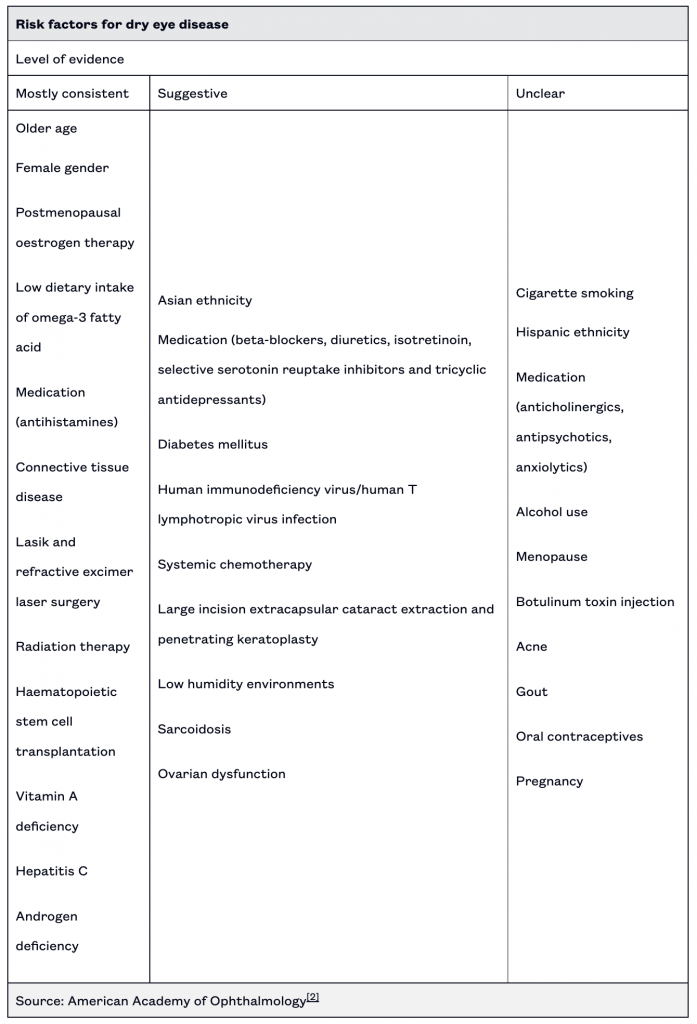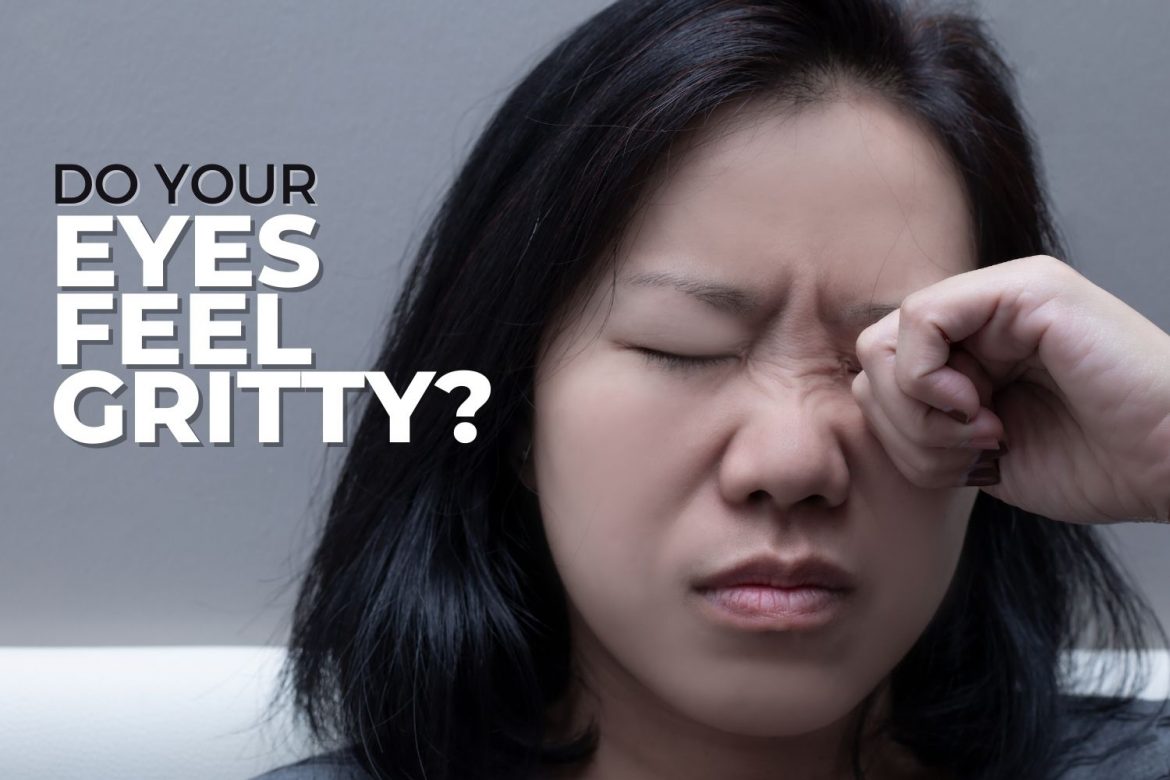![]()
Do your eyes ever feel gritty? Sandy? Do they burn? Feel like a foreign body or eyelash is in them at the end of the day? These symptoms are often due to dry eye disease.
It is estimated that dry eye affects nearly 1 in 5 Americans.
What is dry eye disease?
Dry eye has been defined by researchers as “a disorder of the tear film due to tear deficiency or excessive evaporation, which causes damage to the interpalpebral ocular surface and is associated with symptoms of ocular discomfort.”
Dry eye is due to inadequate tear production (aqueous-deficient) or tear evaporation (meibomian gland dysfunction) resulting in inflammation on the surface of the eye and ocular discomfort.
The lacrimal gland lubricates the eye’s surface by producing one part of the tear film. The meibomian glands are located at the base of your eyelashes and produce the oil that flows into the eye and helps to maintain the balance of the tear film. 85% of all dry eye disease is considered evaporative due to a meibomian gland dysfunction.
Who is at risk for dry eye disease?
Experts cite a long list of possible risk factors for dry eye disease and conclude three consistent factors include (1) older age (2) female gender, and (3) postmenopausal oestrogen therapy.

Modifiable lifestyle risk factors, according to Contact Lens Journal, include increased digital screen exposure time and decreased caffeine consumption. Low-humidity environments, systemic medications, and autoimmune disorders may exacerbate dry eye, according to the National Library of Medicine.
If a medication can be eliminated or the dosage reduced, it may improve dry eye symptoms. Antidepressants, antihistamines, decongestants, hormone replacement/birth control, hypertension and acne meds, Parkinson’s medications, pain relievers, GI meds, chemo meds, and antipsychotics are categories of medications linked to dry eye.
What are the symptoms of dry eye disease?
Symptoms of dry eye disease vary by patient, but may include:
- Itching
- Inconsistent, blurry vision
- Redness
- Watery eyes
- Sandy, gritty eyes
- Foreign body sensation
- Burning
- Asthenopia (eye fatigue)
With dry eye, a patient may have all or some of the symptoms.
What are the newest treatments for dry eye disease?
Prescription eye drops, nasal spray, artificial tears, lid hygiene, and thermal pulse devices are used to treat dry eye.
Artificial tears
There are many different types of artificial tears available on the market. Artificial tears only provide transient relief, but may be used as a supplement to other therapies. A conversation with your eye doctor can determine what type may be best for you. Most will recommend a non-preservative artificial tear. They are often available in little vials vs. bottles. Non-preserved drops should be used when available to avoid eye irritation.
A recent 2020 study identified an artificial tear with a combination of 0.4% hyaluronic acid and 0.2% galactoxyloglucan is the most effective for dry eye treatment. Both clinical signs of dry eye and patient symptoms improved after one month of use.
Nasal spray
Tyrvaya nasal spray is the most recent prescription medication for dry eye. It is the first nasal spray to be approved in the U.S. for this indication. Tyrvaya activates tear film production by helping your body create more natural tears. The exact mechanism for Tyrvaya is unknown.
Prescription eye drops
Xiidra, Restasis, Cequa are the most prescribed eye drops for dry eye disease. Topical cyclosporine A (CsA) is an immunosuppressant that has been widely used to treat inflammatory ocular surface diseases (Restasis, Cequa). It is still unclear whether CsA eyedrops reduce the symptoms and signs of dry eye. Individuals using CsA drops may experience adverse effects, such as burning or stinging.
Lifitegrast (sold under the brand name Xiidra) is a lymphocyte function-associated antigen-1 antagonist used to reduce the inflammatory component of dry eye disease. Lifitegrast has demonstrated a significant improvement in the symptoms of eye dryness as early as day 14. Patients may experience eye burning and a metallic taste after use.
Lid hygiene
Lid hygiene refers to the treatment of meibomian gland dysfunction. A heated eye compress from Bruder, available for over-the-counter purchase, warms the oil in the meibomian glands so it may flow out normally.
Lids scrubs are used to clean the debris, including bacteria, from the eyelashes and lid margins. They can be purchased here at EZContacts, or at any drug store, and should be used daily by those who suffer from evaporative dry eye.
Oral tetracyclines like doxycycline or tetracycline may also be added. Though an antibiotic, the drug class has anti-inflammatory properties and improves oil gland function.
Thermal pulsation devices
There are several different brands of thermal pulsation devices. Thermal pulsation uses the localized application of heat and pressure on the upper and lower eyelids to improve the drainage of the meibomian glands. These glands provide the oil component to the tear film to prevent evaporation and improve tear quality.
How is dry eye disease diagnosed?
Dry eye is diagnosed using a combination of patient symptoms and clinical signs. Some eye doctors will have a patient complete a survey about their eye symptoms called the SPEED questionnaire and use the survey to assess symptom improvement. In addition to a clinical assessment of the lid margins and anterior segment of the eye, there are a few clinical tests performed by a doctor to diagnose dry eye.
Fluorescein/Lissamine green staining dyes
Fluorescein stains both the precorneal tear film and epithelial erosions in the conjunctiva and cornea. Lissamine green stain shows superficially damaged cells with a defective mucin layer. Both demonstrate the eye is dry.
Tear break-up
Tear film break-up time (TFBUT) allows the doctor to grade the stability of your tear film. Your eye doctor instills a drop of fluorescein into your eye and views your eye with a blue light. After a complete blink, the doctor will count the time until the break-up of the tear film. The normal range is between 20-30 seconds, and values below 10 seconds indicate dry eye.
If you have the symptoms of dry eye, contact your doctor for a dry eye evaluation. This testing is likely to be covered by your medical insurance. If your eyes are extremely dry, it may affect the results of your vision test and prescription for glasses or contacts.
SHOP EZCONTACTS EYE CARE SOLUTIONS HERE


